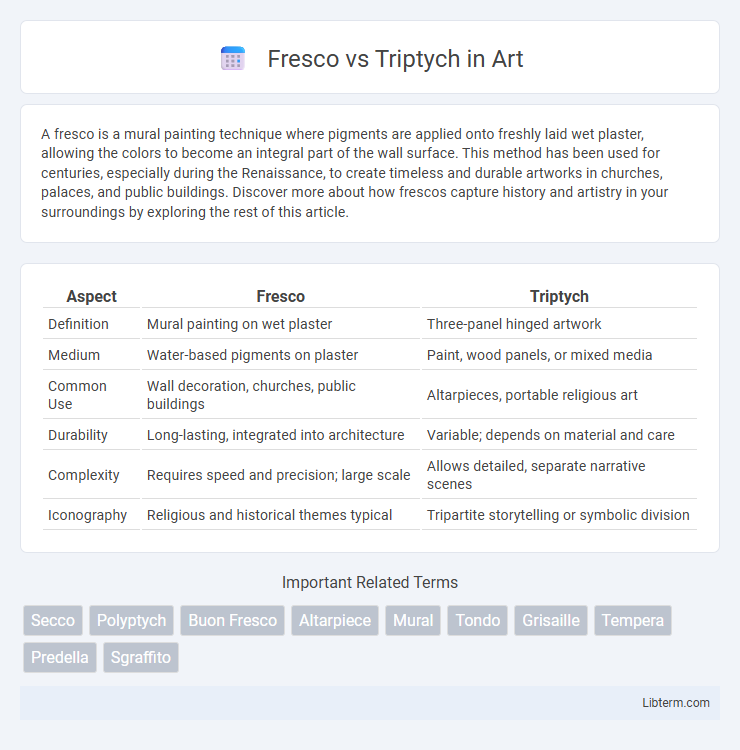A fresco is a mural painting technique where pigments are applied onto freshly laid wet plaster, allowing the colors to become an integral part of the wall surface. This method has been used for centuries, especially during the Renaissance, to create timeless and durable artworks in churches, palaces, and public buildings. Discover more about how frescos capture history and artistry in your surroundings by exploring the rest of this article.
Table of Comparison
| Aspect | Fresco | Triptych |
|---|---|---|
| Definition | Mural painting on wet plaster | Three-panel hinged artwork |
| Medium | Water-based pigments on plaster | Paint, wood panels, or mixed media |
| Common Use | Wall decoration, churches, public buildings | Altarpieces, portable religious art |
| Durability | Long-lasting, integrated into architecture | Variable; depends on material and care |
| Complexity | Requires speed and precision; large scale | Allows detailed, separate narrative scenes |
| Iconography | Religious and historical themes typical | Tripartite storytelling or symbolic division |
Introduction to Fresco and Triptych
Fresco is an ancient mural painting technique where pigments are applied onto freshly laid wet plaster, allowing colors to become an integral part of the wall surface, commonly seen in Renaissance art. Triptych refers to a three-panel artwork, often hinged together, used prominently in altarpieces to convey a narrative through three connected scenes. Both frescoes and triptychs offer distinct methods of storytelling and decoration in religious and historical art contexts.
Historical Origins
Fresco painting originated in ancient civilizations such as Mesopotamia and Egypt, reaching its classical form in the Roman and Renaissance periods with notable examples like Michelangelo's Sistine Chapel ceiling. The triptych, a three-paneled artwork, emerged in the Byzantine era and gained prominence during the medieval and Renaissance periods, often used as an altarpiece in Christian churches. Both art forms reflect religious and cultural narratives, with frescoes being mural paintings executed on wet plaster and triptychs designed as portable or stationary panels for devotional purposes.
Artistic Techniques
Fresco painting involves applying water-based pigments onto freshly laid lime plaster, allowing the colors to chemically bond with the wall for durability and vibrant hues. Triptych artworks consist of three separate panels, often hinged together, which artists paint or carve with complementary scenes that create a cohesive narrative or thematic progression. The fresco technique emphasizes permanence and integration with architectural surfaces, while triptychs prioritize modularity and multi-panel storytelling.
Materials and Tools Used
Fresco painting involves applying pigment mixed with water onto a freshly laid lime plaster surface, requiring specialized tools such as trowels, sponges, and natural brushes for smooth application and blending. Triptych creation typically uses oil or acrylic paints on wood panels or canvas, favoring fine brushes, palette knives, and stretchers to handle multiple hinged panels. The contrasting materials influence durability and texture, with frescoes integrating pigment into plaster for long-lasting murals, while triptychs offer detailed, layered compositions through paint on prepared supports.
Thematic Expression
Fresco art conveys thematic expression through immersive, large-scale murals that integrate with architectural surfaces, emphasizing historical, religious, or mythological narratives. Triptychs enhance thematic depth by dividing a story or concept into three interconnected panels, allowing complex juxtaposition and progression of themes. Both mediums excel in narrative storytelling, but frescoes offer a continuous visual experience, whereas triptychs highlight thematic contrasts and developments.
Religious and Cultural Significance
Frescoes hold profound religious significance as they often depict biblical scenes directly on church walls, creating immersive worship environments that convey theological narratives through vivid colors and monumental scale. Triptychs, typically composed of three hinged panels, serve as portable altarpieces that facilitate private devotion and liturgical functions, symbolizing the Holy Trinity through their tripartite structure. Both mediums play crucial roles in cultural heritage by preserving spiritual artistry and reflecting the devotional practices and iconographic traditions of their respective historical periods.
Notable Examples in Art History
Fresco painting, exemplified by Michelangelo's Sistine Chapel ceiling, showcases vibrant scenes created on wet plaster for durability and vivid color. Triptychs, such as Hieronymus Bosch's "The Garden of Earthly Delights," feature three-panel compositions often used as altarpieces, combining narrative depth with symbolic complexity. Both mediums represent pivotal techniques in art history, reflecting distinct approaches to religious and allegorical storytelling.
Advantages and Challenges
Fresco painting offers exceptional durability and vibrant color longevity due to pigments being absorbed into wet plaster, making it ideal for monumental murals in historical and religious contexts. Triptychs provide a versatile storytelling format by dividing artwork into three panels, enabling narrative complexity and interactive display options, especially in altarpieces. Challenges with fresco include technical difficulty and environmental sensitivity, while triptychs can face issues of cohesion and physical durability across hinged panels.
Contemporary Applications
Fresco techniques remain influential in contemporary mural art, valued for their durability and vibrant color integration on architectural surfaces. Triptych formats are widely used in modern gallery exhibitions, allowing artists to explore sequential narratives or thematic contrasts across three interconnected panels. Both mediums facilitate immersive storytelling, with fresco emphasizing permanence and texture, while triptychs offer versatile spatial arrangements in contemporary art presentations.
Conclusion: Choosing Between Fresco and Triptych
Selecting between fresco and triptych depends on the intended artistic impact and space constraints; frescoes offer a seamless, large-scale narrative ideal for architectural integration, while triptychs provide focused, portable storytelling through three distinct panels. Frescoes demand extensive preparation and permanence, making them suitable for murals in public or sacred spaces, whereas triptychs are versatile, often used in altarpieces or private collections where portability and detailed segmentation are valued. Artists and collectors should consider the environment, desired viewer engagement, and conservation needs when deciding between these art forms.
Fresco Infographic

 libterm.com
libterm.com